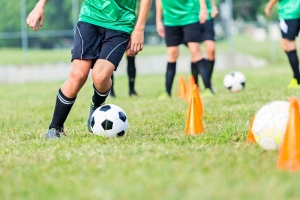Exercise Helps Individuals With Autism

Julia Basso – PhD
Autism Spectrum Disorder (ASD) is a neurodevelopmental disorder that typically emerges before the age of 3. ASD is characterized by a variety of symptoms including impaired social interactions, problems with communication, and engagement in repetitive behaviors. Other issues that can co-occur with ASD include depression, anxiety, difficulties in emotional regulation, and problems with paying attention. Currently, scientists think that ASD results from issues in information processing, arising from errors in how the brain’s cells are connected and organized throughout the brain, especially in the region of the prefrontal cortex (an area involved in mood, social behavior, and cognitive functioning).
Approximately 1% of the world population is currently living with autism, and the Center for Disease Control estimates that 1 in 68 babies born in the United States will be diagnosed with ASD, with significantly higher levels in boys than girls (1 in 42 boys versus 1 in 189 girls) (Center for Disease Control, 2014).
Related Article: Building An Autism Friendly Workout Plan
Stay On Task And Engaged
Currently, no known cure exists for ASD, and many of the medications used to treat ASD have serious side effects, including sedation and weight gain. Because of this, physicians, scientists, and families are turning to alternative treatments. Exercise is one of them. Dr. Stephen M. Edelson, executive director of the Autism Research Center, says that, “One of the most effective treatments for autistic people is exercise.”
He notes that research is showing that exercise is associated with, “decreases in stereotypic (self-stimulatory) behaviors, hyperactivity, aggression, self-injury, and destructiveness” in people with autism. Along with improvements in motor behaviors, exercise has been shown to help in the classroom. In children with ASD, exercise has been shown to enhance the ability to stay on task and engage in classroom activities as well as increase overall academic performance. Importantly, exercise in children with ASD helps to improve social skills.
The Results Are Undeniable
 Compared to individuals without ASD, those with ASD spend significantly less time engaging in physical activities (29 versus 50 minutes per day) and fewer meet the Physical Activity Guidelines for Americans (14 versus 29%) (Stanish et al., 2017). As individuals with ASD often suffer from weight gain and other physical health issues, it is imperative that we encourage these individuals to participate in physical activity. When it comes to the long-term effects of exercise on ASD symptoms, few longitudinal randomized controlled studies have been conducted.
Compared to individuals without ASD, those with ASD spend significantly less time engaging in physical activities (29 versus 50 minutes per day) and fewer meet the Physical Activity Guidelines for Americans (14 versus 29%) (Stanish et al., 2017). As individuals with ASD often suffer from weight gain and other physical health issues, it is imperative that we encourage these individuals to participate in physical activity. When it comes to the long-term effects of exercise on ASD symptoms, few longitudinal randomized controlled studies have been conducted.
What has been done, however, suggests that exercise is beneficial for individuals with ASD. In one study, children with ASD (ages 6 to 9) were exposed to a 10-week water exercise swimming program (Pan, 2010). Participation in the exercise program (compared to engagement in regular treatment/activity) not only enhanced aquatic skills, but importantly decreased antisocial behaviors including spinning, rocking, and delayed echolalia or the verbal repetition of previously heard messages.
When it comes to the long-term effects of exercise on ASD symptoms, few longitudinal randomized controlled studies have been conducted. What has been done, however, suggests that exercise is beneficial for individuals with ASD. In one study, children with ASD (ages 6 to 9) were exposed to a 10-week water exercise swimming program (Pan, 2010). Participation in the exercise program (compared to engagement in regular treatment/activity) not only enhanced aquatic skills, but importantly decreased antisocial behaviors including spinning, rocking, and delayed echolalia or the verbal repetition of previously heard messages.
What Type of Exercise Is Best?
Another more recent study asked whether just a single bout of exercise could be beneficial to improve symptoms in individuals with ASD (Schmitz et al., 2017). Not only that, but the researchers sought to determine which type or “dose” of workout was best. They examined four doses of aerobic exercise:
1) a 10-minute low-intensity workout
2) a 10-minute high-intensity workout
3) a 20-minute low-intensity workout
4) a 20-minute high-intensity workout
Before and 60 minutes after exercise or rest, a variety of stereotypic behaviors were assessed. Excitingly, all exercise regiments decreased stereotypic behaviors, except 20 minutes of high-intensity exercise, which actually exacerbated stereotypic behaviors. The most beneficial workout for ameliorating ASD symptoms was the 10-minute low-intensity aerobic workout, suggesting that a little exercise goes a long way!
Future high-quality studies will be needed to determine whether exercise can be suggested as an evidence-based treatment in children with ASD (Dillon et al., 2017). In the meantime, if you have a child or grandchild with autism, get exercising together. Many children with ASD enjoy sitting at home and engaging in sedentary behaviors such as playing video games. Exercise can be a way to get out of the house and enjoy a healthy activity that you can bond over.
Adaptive Learning
Jackie Ceonzo, Executive Director and Founder of SNACK & Friends, Inc (Special Needs Activity Center for Kids) suggests that sports can be learned and enjoyed by children with ASD. She says that, “They just need to be taught in an adapted fashion…For example, in teaching baseball, start with teaching them to run from home plate to first base. The bases can serve as visual cues. Maybe add some arrows to point out the right direction to move around the bases. A sticker, a high five, or other reinforcers may be needed at the end of a successful run.” If heading outside to exercise seems out of the question, think about combining exercise and video gaming. Video game systems such as the Wii have a variety of interactive exercise games such as Just Dance, EA Sports Active, Exerbeat, and Zumba Fitness World Party.
You can see a list of the best Wii exercise games here. Many phone apps are even available that make exercise into a game, such as Zombies, Run, an interactive walking/jogging/running game that allows you to, “Run in the real world and become a hero in another.” The idea is that you are one of the few remaining souls who have survived a zombie epidemic, and you are running to “one of humanity’s last remaining outposts.” Along the way, you collect supplies, rescue survivors, and get exercise! There is even an app that teaches individuals with autism to exercise, called ExerciseBuddy. As an another idea, think about measuring heart rate as you engage in a workout – tracking heart rate from workout to workout could serve as an additional game.
Related Article: Training Program For Autism
In conclusion,
even a single 10-minute bout of low-intensity aerobic exercise can help improve symptoms in individuals with ASD. If 10 minutes is initially too much, start with half that and build from there. As fitness increases, you can try exercising in 10 minute bouts throughout the day to help boost the benefits. Most importantly, make exercise fun. Getting fit can become a game that the whole family can enjoy!
You Might Like:
Keep Moving – Aerobic Exercise Increases College GPAs
Julia C. Basso, PhD Reporting from the 2017 Annual Society for Neuroscience Meeting (Basso JC, Crosta C, Raskin M, Wang A, Kadakia D, Choi J, Milburn E, Trivedi R, Suzuki WA) Long-term aerobic exercise enhances mood...Exercise May Improve Brain Health In Adolescent Binge Drinking
Julia C. Basso, PhD Reporting from the 2017 Annual Society for Neuroscience Meeting Exercise highlight 5: Voluntary exercise restores adolescent binge ethanol-induced loss of basal forebrain cholinergic neurons in adulthood (RP Vetreno, FT Crews) The...Sense & Movement – A Surprisingly Unique Phenomenon
Julia C. Basso, PhD Reporting from the 2017 Annual Society for Neuroscience Meeting The ability to adapt your movement to signals or cues in the environment is known as sensorimotor adaptation, the focus of one...Learning, Memory, & Decision Making
Julia C. Basso, PhD Reporting from the 2017 Annual Society for Neuroscience Meeting Making good decisions requires memory. Take for example, the hangover (maybe that some of us are experiencing today after the reunion with...What Factors Determine Ultra-Marathon Success?
Julia C. Basso, PhD 100 miles is approximately the distance from the surface of the earth to the planet’s boundary, called suborbital space. This is also the distance run by ultra-marathon racers. To be considered...Exercise & Celiac Disease
Julia C. Basso, PhD Eating gluten free seems to be in fashion at the moment. You can find gluten free foods at almost every super market these days. However, for some gluten free is not...References:
Center for Disease Control (2014): https://www.cdc.gov/ncbddd/autism/data.html.
Dillon, S. R., Adams, D., Goudy, L., Bittner, M., & McNamara, S. (2016). Evaluating exercise as evidence-Based Practice for individuals with Autism Spectrum Disorder. Frontiers in public health, 4.
Pan, C. Y. (2010). Effects of water exercise swimming program on aquatic skills and social behaviors in children with autism spectrum disorders. Autism, 14(1), 9-28.
Schmitz, O. S., Mcfadden, B. A., Golem, D. L., Pellegrino, J. K., Walker, A. J., Sanders, D. J., & Arent, S. M. (2017). The Effects of Exercise Dose on Stereotypical Behavior in Children with Autism. Medicine and science in sports and exercise, 49(5), 983-990.
Stanish, H. I., Curtin, C., Must, A., Phillips, S., Maslin, M., & Bandini, L. G. (2017). Physical Activity Levels, Frequency, and Type Among Adolescents with and Without Autism Spectrum Disorder. Journal of autism and developmental disorders, 47(3), 785-794.










